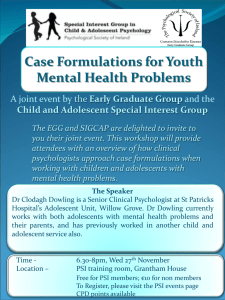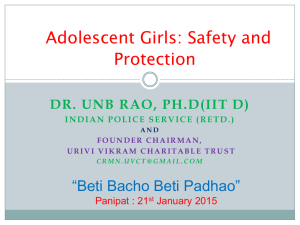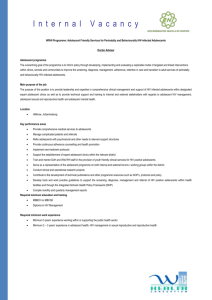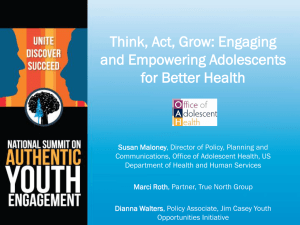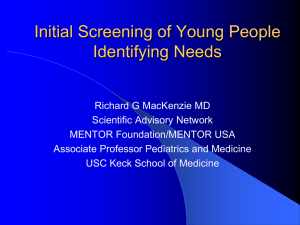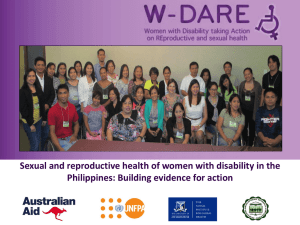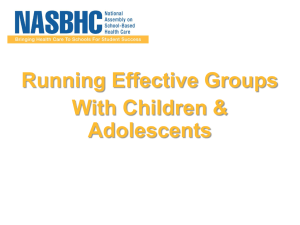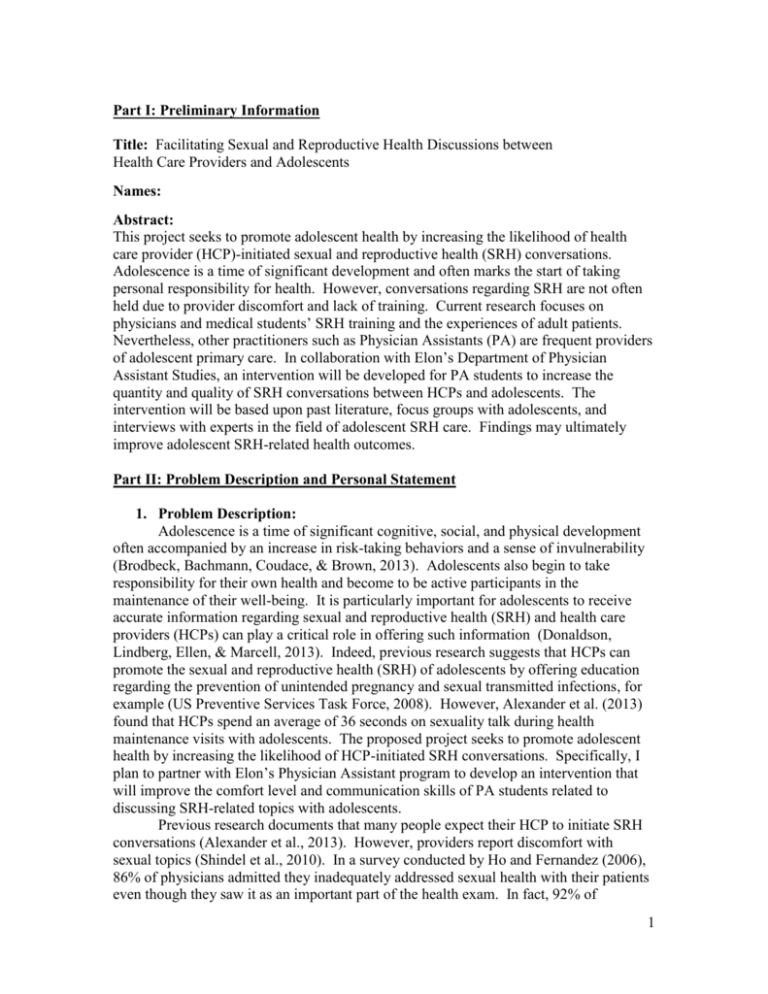
Part I: Preliminary Information
Title: Facilitating Sexual and Reproductive Health Discussions between
Health Care Providers and Adolescents
Names:
Abstract:
This project seeks to promote adolescent health by increasing the likelihood of health
care provider (HCP)-initiated sexual and reproductive health (SRH) conversations.
Adolescence is a time of significant development and often marks the start of taking
personal responsibility for health. However, conversations regarding SRH are not often
held due to provider discomfort and lack of training. Current research focuses on
physicians and medical students’ SRH training and the experiences of adult patients.
Nevertheless, other practitioners such as Physician Assistants (PA) are frequent providers
of adolescent primary care. In collaboration with Elon’s Department of Physician
Assistant Studies, an intervention will be developed for PA students to increase the
quantity and quality of SRH conversations between HCPs and adolescents. The
intervention will be based upon past literature, focus groups with adolescents, and
interviews with experts in the field of adolescent SRH care. Findings may ultimately
improve adolescent SRH-related health outcomes.
Part II: Problem Description and Personal Statement
1. Problem Description:
Adolescence is a time of significant cognitive, social, and physical development
often accompanied by an increase in risk-taking behaviors and a sense of invulnerability
(Brodbeck, Bachmann, Coudace, & Brown, 2013). Adolescents also begin to take
responsibility for their own health and become to be active participants in the
maintenance of their well-being. It is particularly important for adolescents to receive
accurate information regarding sexual and reproductive health (SRH) and health care
providers (HCPs) can play a critical role in offering such information (Donaldson,
Lindberg, Ellen, & Marcell, 2013). Indeed, previous research suggests that HCPs can
promote the sexual and reproductive health (SRH) of adolescents by offering education
regarding the prevention of unintended pregnancy and sexual transmitted infections, for
example (US Preventive Services Task Force, 2008). However, Alexander et al. (2013)
found that HCPs spend an average of 36 seconds on sexuality talk during health
maintenance visits with adolescents. The proposed project seeks to promote adolescent
health by increasing the likelihood of HCP-initiated SRH conversations. Specifically, I
plan to partner with Elon’s Physician Assistant program to develop an intervention that
will improve the comfort level and communication skills of PA students related to
discussing SRH-related topics with adolescents.
Previous research documents that many people expect their HCP to initiate SRH
conversations (Alexander et al., 2013). However, providers report discomfort with
sexual topics (Shindel et al., 2010). In a survey conducted by Ho and Fernandez (2006),
86% of physicians admitted they inadequately addressed sexual health with their patients
even though they saw it as an important part of the health exam. In fact, 92% of
1
physicians who believed they insufficiently talked about sexual health never initiated the
conversation. Further, SRH discussions tend to be based solely on closed-ended
questions for the purposes of taking a sexual history rather than discussions about
lifestyle (Alexander et al., 2013).
Research has identified several factors which increase the likelihood of SRH
conversations between HCPs and adolescents. First, discussions of SRH topics are more
likely to occur when the provider explicitly highlights confidentiality (Lehrer, Pantell,
Tebb, & Shafer, 2007). Second, longer appointments also facilitated SRH conversations
(Alexander et al., 2013). Finally, Rosenthal, Lewis, Succop, & Burlow, (1999) found
that adolescents felt more comfortable discussing SRH topics with their HCP when the
conversation began with less sensitive topics such as school and peers and moved into
more personal matters. However, adolescents also expressed a desire for providers to
directly approach the topics of SRH.
Training about how to discuss SRH topics with patients should be a part of all
curricula for health providers (Haist, Griffith, Hoellein, Talente, Montgomer, & Wilson,
2004). Unfortunately, according to Haboubi and Lincoln (2003), 86% of the physicians
polled had little to no training on numerous sexual health issues and 79% identified lack
of training as the primary reason they avoid SRH related conversations with their
patients. Further, physicians were dissatisfied with their SRH education and felt uneasy
answering related questions. It is a clear trend that many HCPs do not feel comfortable
initiating conversation with their patients and even if initiated, discussions are not
comprehensive. Fortunately, there is evidence that interventions such as role-plays with
standardized patients (Haist et al., 2004) and interviewing techniques (Skelton &
Matthews, 2001) can improve the likelihood of SRH discussions between HCPs and
patients. Yet, the majority of research involves medical students focused on adult
patients. Further, the Affordable Care Act will increase the number of individuals
seeking primary care and federal grants have been given to PA programs across the
country to address the shortage of care providers (Green, Savin & Lu, 2013). The current
project seeks to develop learning modules that will help Elon’s PA students develop
necessary skills to promote effective SRH communication with adolescents.
2. Personal Background and Motivation
The reason a person goes to a health care professional is to seek treatment and
understanding. However, research, and my own past experience, has shown that the
amount of time providers actually spend with their patients is limited and it is difficult to
have lengthy conversations about certain topics, especially sexual and reproductive
health. A review of the literature reveals that medical providers are typically trained to
focus on the patient’s presenting symptoms, not the patient’s lifestyle. I believe this is
where the problem lies; a person’s health is much more than just the disease they do or do
not have. Conversations in the doctor’s office should be more of a dialogue that elicit a
narrative, not just responses to closed-ended questions.
My passion for this topic began in Ghana. I had the opportunity to work in an
OB/GYN clinic with a midwife. Many of the women were scared to talk about their
bodies and this made me wonder how such visit would compare in an American clinic. It
seemed to me that the Ghanaian midwife took more time to get to know her patients than
2
a U.S. HCP. She understood that SRH was not a topic many of these women were
comfortable discussing. This idea intrigued me. I became interested in how a HCP is
supposed to promote health, yet an important part of health is often not even discussed
out of embarrassment or lack of training. This is especially true for adolescents.
Adolescence is a critical time in a person’s life. It is time of significant physical and
social change. SRH decisions made during adolescence can influence an individual’s
trajectory into adulthood. Therefore, it is vital for adolescents to have accurate
information about SRH development. However, HCPs spend little time on this topic and
it seems unlikely they will be able to fully understand their patient and treat him or her in
the most appropriate way. I believe that this project could facilitate SRH conversations
between HCPs and adolescents which may ultimately improve health outcomes.
Part III: Plan for Intellectual Inquiry
A. Researching the nature, causes, and consequences of the problem
In order to gain a well-rounded understanding of the problem, I will first start
broadly by reading a variety of seminal texts focused on the adolescent experience,
adolescent development, and working with adolescents from a variety of disciplines
including:
Greene, J. (2012). The fault in our stars. New York, New York: Penguin Press. The
Fault in Our Stars is a critically acclaimed work of fiction that describes the relationship
between adolescents diagnosed with cancer. Issues of SRH are discussed less frequently
with adolescents who have special healthcare needs than typically developing youth.
This book departs from traditional academic sources of information on adolescents and
therefore offers a unique perspective.
Elkind, D. (1998). All grown up and no place to go: Teenagers in crisis. Rev. ed.
New York, New York: Perseus. David Elkind argues that society forces teenagers to
grow up too quickly. This book will provide important information about the context in
which adolescents need to make decisions surrounding SRH.
Erikson, E. (1994). Identity and the life cycle. New York, New York: W. W. Norton
& Company. Erick Erikson’s book on identity is known as a classic within the field of
developmental psychology. In order to develop effective interventions with adolescents,
I must have a full understanding of the adolescent development.
Naar-King, S. & Suarez, M. (2010) Motivational interviewing with adolescents and
young adults (applications of motivational interviewing). New York, New York: Guilford
Press. Motivational interviewing is a counseling approach used with a variety of
populations to promote positive behavioral change. It is frequently used within the
context of high risk behaviors. I may be able to apply this type of intervention to
promote productive conversations between medical providers and adolescents.
Fortin, A., Dwamena, F., Frankel, R., & Smith, R. (2012). Smith’s patient-centered
interviewing: An evidence-based method. New York, New York: McGraw-Hill.
According to experts in the field of medical education, Smith’s Patient-Centered
Interviewing is the “gold standard” of texts for students entering the medical field. It is
important for me to be familiar with the standard practices of care if I am going to ask PA
students to change their approach to working with adolescents.
3
These readings will help me place adolescence within a broader context and
inform the development of a creative and innovative intervention which draws upon a
rich variety of sources. Further, my study abroad this fall in Copenhagen, Denmark will
offer a cross-cultural perspective on healthcare as Denmark has one of the best health
systems in the world. One of my classes, Health Delivery and Prioritization, will help me
understand their health system including their approach to offering SRH care to
adolescents.
I also plan to place SRH within the larger umbrella of adolescent health by
attending a variety of conferences. First, I plan to attend the Society for Adolescent
Health and Medicine (SAHM) in Los Angeles, California on March 18-21, 2015. SAHM
is an interdisciplinary organization that seeks to improve the lives of adolescents through
many health related areas. Here I will come into contact with many HCPs who work
directly with adolescents. Their insights into how to establish rapport with adolescents
and engage them in meaningful dialogue about SRH will inform my intervention. While
at SAHM, I plan to interview leaders within adolescent health and medicine to learn more
about SRH best practices. I also hope to present my findings at the spring, 2016 SAHM
conference in Washington, DC. Second, I plan to attend the American Public Health
Association (APHA) conference on November 7-11, 2015 in Chicago, Illinois. It is a
conference where public health professionals meet to learn, network, and engage with
other professionals. I hope that this conference will help me gain a fuller understanding
of current SRH-related public health research. It also will allow me to network with other
people interested in adolescent, sexual and reproductive health.
The above-mentioned experiences will help me gain a broad perspective on
adolescent SRH. It is also important to study specific relevant stakeholders. The
literature suggests that many issues can best be understood by using triangulation which
involves utilizing data from multiple sources and integrates a combination of research
methodologies (Bogdan & Biklen, 2006). Therefore, in order to discover new material
that will inform innovative ways to address the problem I plan to gather information from
adolescents themselves, PA students, and experts in the field of PA education and
adolescent sexual and reproductive health.
I plan to hold focus groups with both male and female adolescents. Questions
will center on their past experiences with providers and of conversations related to sexual
and reproductive health. Information from the focus group will provide me with real life
examples of provider-patient communication and current perspectives and will allow me
to integrate adolescents’ voices and feedback into an intervention.
I ultimately plan to work with the students in Elon’s Department of Physician
Assistant Studies. My intervention will center on supporting effective adolescentprovider communication about SRH. Therefore, I will need to assess their current SRHrelated knowledge and attitudes before and after the intervention. I also plan to combine
qualitative data (focus groups and interviews) along with quantitative surveys designed to
assess PA’s levels of knowledge and comfort with SRH as well as their perceived
training needs on the topic of adolescent SRH.
I also plan to talk with Professor Alexis Moore, an Assistant Professor at the Elon
Department of Physician Assistant Studies. She holds a Masters of Science in Physician
Assistant Studies and a Masters of Public Health. Her clinical and research interests
include adolescent HIV, behavioral health, as well as SRH. She is responsible for
4
teaching many different components of the PA education modules including SRH and
patient-provider communication. Professor Moore’s expertise and current position at
Elon will shed new light on ways to foster adolescent-provider relationships and identify
strategies for teaching this original material to PA students. I plan to meet with her to
discuss current training techniques and her past clinical work and research in this area.
Finally, I plan to complete an internship in New York City Health and Hospitals
Corporation. This particular program recently implemented an innovative training
program for HCPs designed to prepare providers to improve communication with
adolescent patients. The program involved adolescent standardized patients who were
assigned a variety of health concerns including the need for birth control and STI testing
as well as symptoms related to depression. Participating HCP’s evaluated the patient and
were later given feedback on their interactions. Studying such a program would inform
the development of an intervention with Eon’s PA students.
The experiences identified above, along with my current and future coursework,
will prepare me to effectively create and execute an innovative intervention with the Elon
University Department of Physician Assistant Studies to improve the quality and
frequency of SRH conversations with adolescents.
B. Researching the ways leadership theories and examples inform solution
implementation
The literature on current relationships between adolescents and providers shows
that providers spend minimal time communicating with adolescents about SRH. This is
where an understanding of leadership theory is vital. Much of the literature also revealed
that the poor quality of conversation is due to social backgrounds, expectations, and
training. This is very much in line with the Social Construction Theory, which states that
one’s reality is objectified based on one’s opinions and past experiences. This can
become a problem when talking about sensitive topics with adolescents who may have
different opinions and past experiences.
Therefore in order to change the PA students’ social construct, it will be necessary
to use Kurt Lewin’s model for change that he created in the 1950’s (Hatch, 2006). There
are three steps associated with Lewin’s model that will facilitate the development of
learning modules. The first step is unfreezing which is supposed to break apart a person’s
current behavioral patterns that may act as resistance to the desired change. For this
project, the unfreezing stage will most likely include a pretest on current opinions and
conversations talking about where the discomfort comes from. The next step Lewin
described was called movement which involves influencing people to the desired
outcome and is where the proposed training will come into play. The training will teach
new skills that will allow providers to feel more comfortable discussing SRH with their
adolescent patients. The last step, refreezing, institutionalizes the new behavioral
patterns. In this proposed study, refreezing will occur by using a posttest after the
training program. The application of Lewin’s model will facilitate a change in the PA
students’ social construct so they understand how to have open communication with
adolescents.
In order to effectively apply this theory, it will be necessary for me to continue
my leadership training. This will occur through the Elon Leadership Education and
5
Development program, which will include finishing the third tier consisting of three
workshops, service and my leadership minor. These experiences will allow me to better
understand leadership.
Part IV: Feasibility, Budget and Timeline
Feasibility
The proposed project of study is feasible for the timeframe of this prize. Professor
Moore from Elon’s Department of Physician Assistant Studies has expressed interest in
collaborating and therefore I will have direct access to administrators, professors and
students. By utilizing the department and on-campus undergraduate students, the project
will be able to be completed at Elon. The two-year timeframe will provide a year to
develop the training and a year to implement and assess the outcomes.
The budget is divided into two main categories. The first category of costs will be
for my actual research. This includes an audio recorder, transcription costs, and
qualitative analysis software/training as well as incentives for the participants and
training materials. The second category of the budget is associated with deepening my
understanding of adolescent and public health overall and includes memberships to the
Society of Adolescent Medicine and the American Public Health Association. I have also
included funds for an internship in New York City. The budget will also allow me to
attend annual meetings and these conferences will provide me with networking
opportunities and a fuller understanding of the issues associated with SRH
communication between HCPs and adolescents.
6
Budget
Books
o Greene, J. (2012). The fault in our stars. New York,
New York: Penguin Press.
o Elkind, D. (1998). All grown up and no place to go:
Teenagers in crisis. Rev. ed. New York, New York:
Perseus.
o Erikson, E. (1994). Identity and the life cycle. New
York, New York: W. W. Norton & Company.
o Naar-King, S. & Suarez, M. (2010) Motivational
interviewing with adolescents and young adults (applications
of motivational interviewing). New York, New York:
Guilford Press.
o Fortin, A., Dwamena, F., Frankel, R., & Smith, R. (2012).
Smith’s patient-centered interviewing: An evidence-based
method. New York, New York: McGraw-Hill.
$10.00
$17.00
$16.00
$27.00
$30.00
Equipment
o Olympus Digital Voice Recorder
$40
o Transcription service ($1/min)
2 ½ hour men focus groups X 2 ½ hour women
focus groups (120 min.)
$120
Interviewee Incentives
o 2 men focus groups X 2 women focus groups (8 per focus
group = 32 interviewees X $20.00 each)
$640
o 10 Physician Assistant Students X $20.00 each
Training Supplies
o Training DVDs, etc.
Computer software
o Atlas TI and - training
$200
Association Memberships
o SAHM (2 years)
o APHA (2 years)
Conferences
o SAHM Conference (March 18-20, 2015)
Round Trip Flight from Greensboro to Los Angeles
Airport parking
Hotel ($150.00 X 3 days)
Food
o APHA Conference (November 7-9, 2015)
Round Trip Flight from Greensboro to Chicago
Airport parking
Hotel ($150.00 X 3 days)
Food
$2,900
$500
$150
$150
$525
$50
$450
$200
$300
$50
$450
$200
7
o SAHM Conference (Spring 2016)
Round Trip Flight from Greensboro to DC
Airport parking
Hotel ($150.00 X 3 days)
Food
$200
$50
$450
$200
Summer 2015 Internship- New York City’s Health and Hospital Corporation
o Housing/food
$1500
o Transportation
$375
Total
$10,000
8
Timeline
Spring 2014
Proposal
Fall 2014
Copenhagen
December 2015
Apply for SURE
January 2015
Meet with Alexis Moore
March 2015
SAHM conference in Los Angeles, CA
February –May 2015
Hold focus groups with undergraduate and
current PA students
May-July 2015
Create pre-test, training modules and posttest
Participate in SURE if funded
August 2015
Internship in NYC
September 2015
Begin trial run of training module by
giving pre-test
September-December 2015
Conduct training modules
November 2015
Attend APHA conferences in Chicago
January 2016
Give post-test and receive feedback
March 2016
SAHM conference in Washington D.C.
February- May 2016
Report results and finalize training
9
Part V: List of sources
Alexander S., Fortenberry J., Pollak K., Bravender, T., Davis, J., Ostbye, T., Tulsky, J.,
Dolor, R., & Shields, C. (2013). Sexuality talk during adolescent health
maintenance visits. Journal of the American Medical Association Pediatrics. 168,
163-169.
Baraitser, P., Elliot, L., & Bigrigg, A. (1998). How to talk about sex and do it well: a
Course for medical students. Medical Teacher, 20, 237-240.
Bogdan, R. C. & Biklen, S. K. (2006). Qualitative research in education: An introduction
to theory and methods. Boston: Allyn & Bacon.
Brodbeck, J., Bachmann, M., Coudace, T., & Brown, A. (2013). Comparing growth
trajectories of risk behaviors from late adolescence through young adulthood: An
accelerated design. Developmental Psychology, 49, 1732-1738.
Donaldson, A., Lindberg, L., Ellen, J., & Marcell, A. (2013). Receipt of sexual health
information from parents, teachers, and healthcare providers by sexually
experienced U.S. adolescents. Journal of Adolescent Health, 53, 235-240.
Emmers-Sommers, T., Nebel, S., Allison, M., Cannella, M., Cartmill, D., Ewing, S.,
Horvath, D., Osborne, J., Wojtaszek, B. (2009)Patient-provider communication
about sexual health; the relationship with gender, age, gender-stereotypical beliefs
and perceptions of communication inappropriateness. Sex Roles, 60, 669-681.
Green, L., Savin, S., & Lu, Y. (2013). Primary care physician shortages could be
eliminated through use of teams, nonphysicians, and electronic communication.
Health Affairs, 32, 11-19.
Haboubi, N., & Lincoln, N. (2003). Views of health professionals discussing sexual
issues with patients. Disability and Rehabilitation, 25, 291-296.
Haist, S., Griffith, C., Hoellein, A., Talente, G., Montgomer, T., & Wilson, J. (2004).
Improving Students' sexual history inquiry and HIV counseling with an
interactive workshop using standardized patients. Journal of General Internal
Medicine, 19, 2, 549-553.
New York City Health and Hospitals Corporation training program using young patient
actors helps physicians improve communication, better treat adolescents. (2014).
http://www.nyc.gov/html/hhc/html/news/press-release-20140117-adolescentprogram.shtml. Accessed May 4, 2014.
Ho, T. & Fernandez, M. (2006). Patient's sexual health: do we care enough?. Journal of
Renal Care, 32, 183-186.
Kelly, P (2012). Should we rethink how we teach cultural competency in Physician
Assistant education. Journal of Physician Assistant Education, 23, 42-45.
Lehrer, J.A., Pantell, R., Tebb, K., & Shafer, M.A. (2007). Forgone health care among
US adolescents: associations between risk characteristics and confidentiality
concern. Journal of Adolescent Health, 40, 218-226.
Papaharitou, S., Nakopoulou, E., Moraitou, M., Tsimtsiou, Z., Konstantinidou, E., &
Hatzichristou, D. (2008). Exploring Sexual Attitudes of Students in Health
Professions. Journal of Sexual Medicine, 5, 1308-1316.
Politi, M., Clark, M., Armstrong, G., McGarry, K., & Sciamanna, C.(2009). Patientprovider communication about sexual health among unmarried middle-aged and
older women. Journal for General Internal Medicine, 24, 511-516.
10
Rosenthal, S., Lewis, L., Succop, P., & Burlow, K. (1999). Adolescents' views regarding
sexual history taking. Clinical Pediatrics, 38, 227-233.
Shindel, A., Ando, K., Nelson, C., Breyer, B., Lue, T., & Smith, J (2010). Medical
student sexuality: how sexual experience and sexuality training impact U.S. and
Canadian medical students' comfort in dealing with patients' sexuality in clinical
practice. Academic Medicine, 85, 1321-1330.
Skelton, J., & Matthews, P. (2001). Teaching sexual history taking to health care
professionals in primary care. Medical Education, 35, 603-608.
US Preventive Services Task Force. (2008). Behavioral counseling to prevent sexually
transmitted infections: US Preventive Services Task Force recommendation
statement. Annals of Internal Medicine, 149, 491-496, W95.
Wolf, C. (2012). Exploring the sexual attitudes of physician assistant students:
implications for obtaining a sexual history. Journal of Physician Assistant
Education, 23, 30-34.
11

